|
|
|
Sort Order |
|
|
|
Items / Page
|
|
|
|
|
|
|
| Srl | Item |
| 1 |
ID:
142608
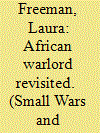

|
|
|
|
|
| Summary/Abstract |
To date, warlordism in Africa has been viewed solely negatively. This has come about, in part, because of the analytical lenses that have been used. Typically, warlordism has been examined at the state level; and behavioural traits, rather than definitionally necessary components, have been the focus. In effect, ‘warlord’ has been confused with other violent actors. I suggest here a reconceptualisation ‘from below’, which takes into account variation in types of warlordism, and which allows for both positive and negative effects of warlordism on society and the state.
|
|
|
|
|
|
|
|
|
|
|
|
|
|
|
|
| 2 |
ID:
142605
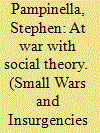

|
|
|
|
|
| Summary/Abstract |
As US counterinsurgency campaigns draw to a close, doctrine for asymmetric warfare written during the War on Terror has come under heavy criticism. While many have argued that this shift to ‘winning hearts and minds’ is evidence that the United States is taking humanitarianism and nation-building seriously, others argue that a wide gap exists between US counterinsurgency doctrine and the protection of civilians afflicted by conflict. In this article, I show that the latter is true by comparing theories of instrumental and communicative action to US doctrine for operational design, stability operations, and counterinsurgency. I argue that these texts treat the people as an object to be manipulated for the achievement of pre-determined self-interested strategic goals rather than members of a community that jointly designs operations to fulfill shared objectives. However, US doctrine does contain communicative elements that, if prioritized, would better support humanitarian and state-building objectives otherwise subordinated in the War on Terror.
|
|
|
|
|
|
|
|
|
|
|
|
|
|
|
|
| 3 |
ID:
142609
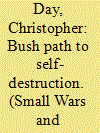

|
|
|
|
|
| Summary/Abstract |
This article explains the demise of Sierra Leone's Revolutionary United Front (RUF) rebellion. It argues that the main cause of this fate was the group's relationship with its primary sponsor, Charles Taylor. The RUF's dependency on Taylor's patronage, coupled with the rebellion's weak organisational endowments harmed the group's prospects of success. Based on original research, the article shows how Taylor used the RUF as a strategic instrument for his own regional interests, which led to the group's unravelling. More broadly, the article speaks about proxy warfare in Africa and how the relationship between resource flows and rebellion are not always beneficial to rebels as one might expect.
|
|
|
|
|
|
|
|
|
|
|
|
|
|
|
|
| 4 |
ID:
142606


|
|
|
|
|
| Summary/Abstract |
Croatia's successful bid for independence was one of the defining moments of the immediate post-Cold War period. Nevertheless, the means that Croatia used to obtain independence remains relatively unexamined by academics. This article focuses on the early period of Croatia's bid for secession, and specifically the role that Yugoslavia's policy of Total National Defence played in facilitating its independence. Unlike in Slovenia, where the legacies of Total National Defence facilitated Slovenia's bid for secession, in Croatia the decision of its political leaders meant that the country largely neglected its positive legacies, resulting in a protracted four-year struggle.
|
|
|
|
|
|
|
|
|
|
|
|
|
|
|
|
| 5 |
ID:
142607
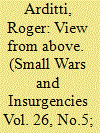

|
|
|
|
|
| Summary/Abstract |
It has long been held that the Federation of Malaya’s counter-insurgency campaign during the First Malayan Emergency (1948–60) was determined by the use of intelligence. Special Branch — the Federation’s primary intelligence agency — dominates the prevailing paradigm of how the insurgent threat was tackled. Conversely, the role of the Royal Air Force (RAF) within this paradigm is very limited. Most observers simply dismiss the role of photoreconnaissance or airstrikes as being largely inconsequential to the counter-insurgency effort. This is perhaps understandable: the Emergency was after all a ‘policing action’ and the insurgents were largely hidden under Malaya’s jungle canopy and amongst the Chinese community. However, further scrutiny reveals that the RAF made a much more significant contribution to the intelligence element of the counter-insurgency campaign than previously realised. First, the RAF decided to locate their Advanced Headquarters with the Army’s General Headquarters. This led to the creation of the Land/Air Operations Room, through which intelligence, tasking and resources were coordinated. Moreover, the RAF put its intelligence teams into the field to provide a practical link between local units and theatre-level assets. Second, with the support of the Army, the RAF established at the beginning of the Emergency the Joint Air Photographic Intelligence Board (Far East). This coordinated all photographic intelligence requirements throughout the Emergency, which was then delivered via the Joint Air Photographic Centre (Far East). Hence, via Joint Operations Centre and JAPIB (FE), the RAF provided both the practical means for effective joint intelligence operations at theatre level throughout the Emergency.
|
|
|
|
|
|
|
|
|
|
|
|
|
|
|
|
| 6 |
ID:
142610
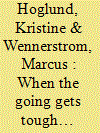

|
|
|
|
|
| Summary/Abstract |
This article analyzes how the conflict environment in which a civilian monitoring mission is deployed influences the monitors' assessment of the operation. It draws on unique empirical material from the experience of the Sri Lanka Monitoring Mission (SLMM), deployed to oversee a ceasefire agreement in Sri Lanka 2002–2008. With material from a survey and in-depth interviews, experiences of the monitors are analyzed and changes over time are traced in relation to the monitors' assessment of the mandate and organizational set-up of the mission. The study points to the difficulty of monitoring missions to address escalation during an ongoing peace process. Its function is dependent on the goodwill of the parties. In essence, monitoring missions have the potential to strengthen peace when there is momentum in favor of progress, but when relations between the parties turn sour and the conflict escalates a civilian monitoring mission basically loses its potential. During the final stages of the war, which saw a very large number of civilian casualties, the war-torn areas were closed to international observers. Moreover, international pressure for a short-term ceasefire to alleviate the humanitarian situation was dismissed by the Sri Lankan government, which also saw the backing of several important actors, not the least China.
|
|
|
|
|
|
|
|
|
|
|
|
|
|
|
|
|
|
|
|
|